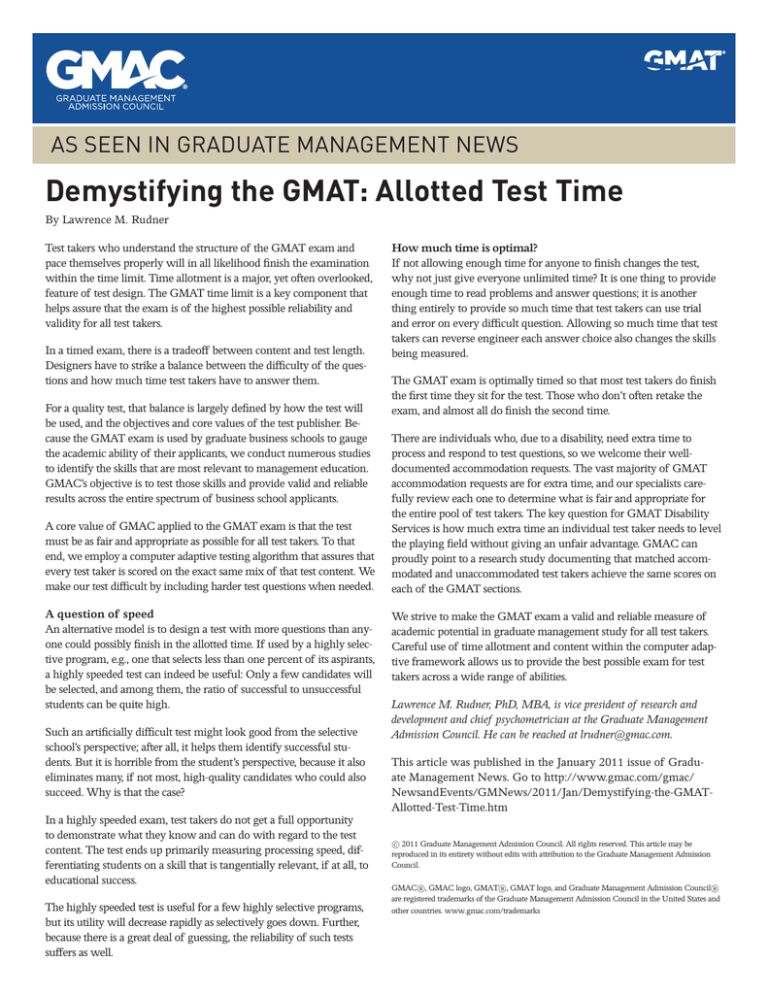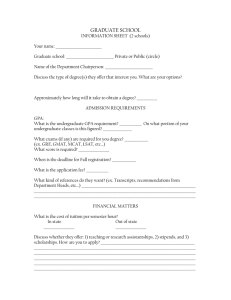
As seen in Graduate Management News
Demystifying the GMAT: Allotted Test Time
By Lawrence M. Rudner
Test takers who understand the structure of the GMAT exam and
pace themselves properly will in all likelihood finish the examination
within the time limit. Time allotment is a major, yet often overlooked,
feature of test design. The GMAT time limit is a key component that
helps assure that the exam is of the highest possible reliability and
validity for all test takers.
In a timed exam, there is a tradeoff between content and test length.
Designers have to strike a balance between the difficulty of the questions and how much time test takers have to answer them.
For a quality test, that balance is largely defined by how the test will
be used, and the objectives and core values of the test publisher. Because the GMAT exam is used by graduate business schools to gauge
the academic ability of their applicants, we conduct numerous studies
to identify the skills that are most relevant to management education.
GMAC’s objective is to test those skills and provide valid and reliable
results across the entire spectrum of business school applicants.
A core value of GMAC applied to the GMAT exam is that the test
must be as fair and appropriate as possible for all test takers. To that
end, we employ a computer adaptive testing algorithm that assures that
every test taker is scored on the exact same mix of that test content. We
make our test difficult by including harder test questions when needed.
A question of speed
An alternative model is to design a test with more questions than anyone could possibly finish in the allotted time. If used by a highly selective program, e.g., one that selects less than one percent of its aspirants,
a highly speeded test can indeed be useful: Only a few candidates will
be selected, and among them, the ratio of successful to unsuccessful
students can be quite high.
Such an artificially difficult test might look good from the selective
school’s perspective; after all, it helps them identify successful students. But it is horrible from the student’s perspective, because it also
eliminates many, if not most, high-quality candidates who could also
succeed. Why is that the case?
In a highly speeded exam, test takers do not get a full opportunity
to demonstrate what they know and can do with regard to the test
content. The test ends up primarily measuring processing speed, differentiating students on a skill that is tangentially relevant, if at all, to
educational success.
The highly speeded test is useful for a few highly selective programs,
but its utility will decrease rapidly as selectively goes down. Further,
because there is a great deal of guessing, the reliability of such tests
suffers as well.
How much time is optimal?
If not allowing enough time for anyone to finish changes the test,
why not just give everyone unlimited time? It is one thing to provide
enough time to read problems and answer questions; it is another
thing entirely to provide so much time that test takers can use trial
and error on every difficult question. Allowing so much time that test
takers can reverse engineer each answer choice also changes the skills
being measured.
The GMAT exam is optimally timed so that most test takers do finish
the first time they sit for the test. Those who don’t often retake the
exam, and almost all do finish the second time.
There are individuals who, due to a disability, need extra time to
process and respond to test questions, so we welcome their welldocumented accommodation requests. The vast majority of GMAT
accommodation requests are for extra time, and our specialists carefully review each one to determine what is fair and appropriate for
the entire pool of test takers. The key question for GMAT Disability
Services is how much extra time an individual test taker needs to level
the playing field without giving an unfair advantage. GMAC can
proudly point to a research study documenting that matched accommodated and unaccommodated test takers achieve the same scores on
each of the GMAT sections.
We strive to make the GMAT exam a valid and reliable measure of
academic potential in graduate management study for all test takers.
Careful use of time allotment and content within the computer adaptive framework allows us to provide the best possible exam for test
takers across a wide range of abilities.
Lawrence M. Rudner, PhD, MBA, is vice president of research and
development and chief psychometrician at the Graduate Management
Admission Council. He can be reached at lrudner@gmac.com.
This article was published in the January 2011 issue of Graduate Management News. Go to http://www.gmac.com/gmac/
NewsandEvents/GMNews/2011/Jan/Demystifying-the-GMATAllotted-Test-Time.htm
© 2011 Graduate Management Admission Council. All rights reserved. This article may be
reproduced in its entirety without edits with attribution to the Graduate Management Admission
Council.
GMAC®, GMAC logo, GMAT®, GMAT logo, and Graduate Management Admission Council®
are registered trademarks of the Graduate Management Admission Council in the United States and
other countries. www.gmac.com/trademarks


